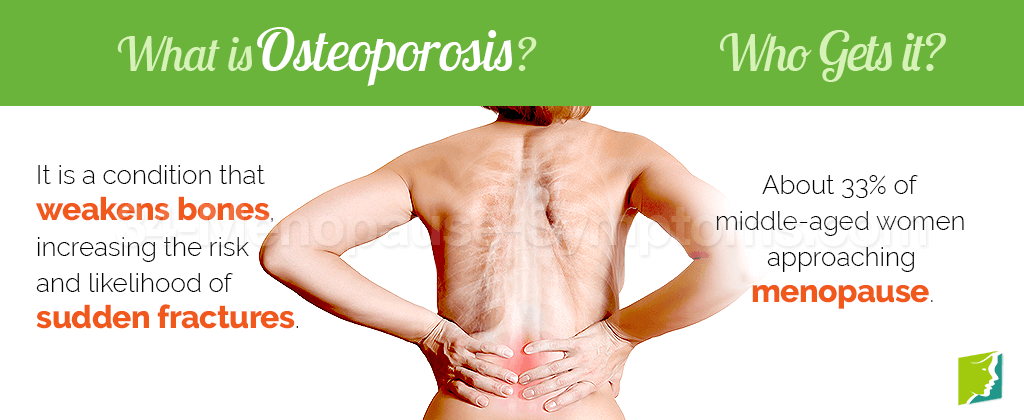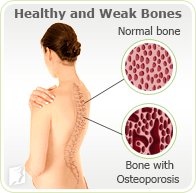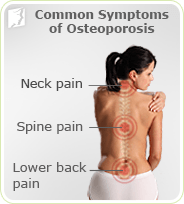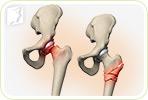Did you know?
Up to 70% of the world's population doesn't get enough calcium in their diet.
Osteoporosis is one of the most serious menopause symptoms because it can lead to severe health problems, such as chronic back pain and broken bones. Not only does osteoporosis threaten a woman's physical health, but the disease can come on slowly and remain unnoticed until a fracture occurs.
About 33% of women over 50 will experience bone fractures as a result of osteoporosis. It's no coincidence that 50 years old is the average age women go through menopause. The hormonal fluctuations that precede menopause and the permanently low hormonal levels of postmenopause play a major role in the onset of osteoporosis. It's important to better understand osteoporosis to know how to prevent and treat it. Continue reading below to learn about osteoporosis and its symptoms and what contributes to bone health.
What Is Osteoporosis?
Osteoporosis, meaning "porous bone," is a degenerative disease that weakens bones and increases the risk of sudden and unexpected fractures. The disease is marked by an increased loss of bone mass and strength. It often progresses without any symptoms or pain. Generally, osteoporosis is not diagnosed until weakened bones cause painful fractures, usually in the back or hips. Once an osteoporosis fracture occurs, there is a much higher risk of additional bone fractures.
Up to 80% of osteoporosis sufferers are women. The disease can also affect men, but at a drastically lower rate than women. This is because men generally have stronger, bulkier bones that do not lose their mass as easily. Men who do suffer from osteoporosis generally get it later in life than women.
Because women are more susceptible to developing osteoporosis, they have to take greater care to prevent or treat the disease.

Bone health
Bone health is vital for overall well-being. This is because bones, which make up the skeleton, are the architectural framework on which the rest of the body is built. Good bone health begins early in life. Typically, the teenage years and young adulthood determine how healthy bones will be later in life. This is the time when bones grow most dramatically and require large amounts of calcium for strength and density.
Teenagers build more than 25% of their adult bone mass. By the time their growth spurts are exhausted, at about age 17, 90% of adult bone mass has been built.
Calcium and healthy bones

The human body stores 99% of its calcium in the bones and teeth. Like every part of the body, the bones are continuously regenerating themselves, losing cells and dividing new ones. As bones grow, they rely on calcium as structural material to build the proper density. Later in life, the amount of cells lost outnumbers the amount of new cells the bones generate. Calcium is vital not only during the teenage years and young adulthood when bones grow the most, but also later in life to retain as much bone mass as possible. Below is information about recommended amounts of calcium intake per day and foods that are high in calcium.
Calcium Recommendations
Children 1 - 3 years -- 500 Children 4 - 8 years -- 800 mg Youth 9 - 18 years -- 1,300 mg Adults 19 - 50 years -- 1,000 mg Adults 51+ years -- 1,200 mg
Foods High in Calcium:
- Most dairy products
- Soy and rice milk
- Chinese cabbage
- Dried figs
- Cooked greens
- Varieties of fish
- Tofu
Symptoms of Osteoporosis
Did you know?
A person with osteoporosis can lose as many as six inches (15 cm) in height as a result of the disease.
One of the main issues with the onset of osteoporosis is that many people who begin developing it do not realize they are afflicted until they experience a bone fracture as a result. For that reason, it's important to take a proactive approach and prevent osteoporosis. Symptoms generally begin to occur late in the disease when there are not many ways to regain bone density.
Common Symptoms of Osteoporosis

- Loss of height as the result of a weakened spine
- Fractured bones, especially hip bones
- Cramps in the legs at night
- Bone pain and tenderness
- Neck, spine, and lower back pain
- Abdominal pain
- Tooth loss
- Rib pain
- Broken bones
- Fatigue
- Periodontal disease
- Brittle fingernails
- Visible spinal deformities such as stooped posture, an outward curve at the top of the spine as a result of developing a vertebral collapse in the back
With a solid understanding about what osteoporosis is and its symptoms, it's time to beginning learning about osteoporosis risk factors.
Sources
- Christenson, E.S. et al. (2012). Osteoporosis management in post-menopausal women. Minerva Ginecologica, 64(3), 181-194. Retrieved from http://www.ncbi.nlm.nih.gov/pubmed/22635014
- Cleveland Clinic. (n.d.). Menopause and Osteoporosis. Retrieved May 10, 2016, from https://my.clevelandclinic.org/health/diseases_conditions/hic-what-is-perimenopause-menopause-postmenopause/hic_Menopause_and_Osteoporosis
- New York State Department of Health. (2015). Calcium and Healthy Bones. Retrieved May 10, 2016, from https://www.health.ny.gov/publications/1982.pdf
- Office on Women's Health. (2012). Osteoporosis fact sheet. Retrieved May 10, 2016, from http://www.womenshealth.gov/publications/our-publications/fact-sheet/osteoporosis.html
- University of Maryland Medical Center. (2015). Osteoporosis. Retrieved May 10, 2016, from http://umm.edu/health/medical/altmed/condition/osteoporosis
- U.S. Department of Health and Human Services. (n.d.). 18 Ways Smoking Affects Your Health. Retrieved May 10, 2016, from http://smokefree.gov/health-effects



